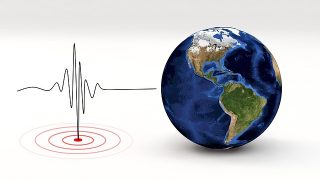by Karen Faulkner, Worthy News Correspondent
(Worthy News) – Israeli scientists have published a study detailing a method by which a major earthquake can be predicted with 80% accuracy 48 hours before it strikes, the Jerusalem Post reports. Devastating, deadly earthquakes have occurred in all parts of the world, including the Far East and Europe, and are not confined to specific regions.
Funded by Israel’s Energy Ministry and the Israel Science Foundation, the peer-reviewed study was published in May in the scientific journal Remote Sensing. The research was led by Dr. Yuval Reuvani, Dr. Li-Ad Gotlieb, and Dr. Nimrod Inbar of Ariel University and the Center for Research & Development Eastern Branch and doctoral student Said Asali from the Department of Computer Science at Ariel University, JPost reports.
The researchers made their discovery by studying changes in the Earth’s ionosphere, where the atmosphere meets space, JPost said. Defining a major earthquake as being stronger than Mw 6 on the Moment magnitude scale, the study led to an evaluation of potential precursors to several major earthquakes that occurred in the past 20 years.
The researchers went on to develop a method to accurately predict earthquakes involving the implementation of a “machine learning support vector machine (SVM) technique, applied with GPS map data of ionospheric total electron content to calculate its electron charge density,” JPost said in its report.
The most devastating earthquakes of the last 12 years alone include the 2011 disaster in Japan, which took thousands of lives, and the 2010 catastrophe in Haiti, which killed 315,000 people. However, there have been numerous other smaller but deadly quakes in recent years, including in Italy, Pakistan, New Zealand, China, and Turkey.
Copyright 1999-2024 Worthy News. This article was originally published on Worthy News and was reproduced with permission.
The following code is how the above article is generated with the Worthy Suite WordPress Plugin.
[worthy_plugins_news_story_body]This is how you display a story with an image.
Israeli scientists discover method to accurately predict major earthquakes

by Karen Faulkner, Worthy News Correspondent
(Worthy News) – Israeli scientists have published a study detailing a method by which a major earthquake can be predicted with 80% accuracy 48 hours before it strikes, the Jerusalem Post reports. Devastating, deadly earthquakes have occurred in all parts of the world, including the Far East and Europe, and are not confined to specific regions.
Funded by Israel’s Energy Ministry and the Israel Science Foundation, the peer-reviewed study was published in May in the scientific journal Remote Sensing. The research was led by Dr. Yuval Reuvani, Dr. Li-Ad Gotlieb, and Dr. Nimrod Inbar of Ariel University and the Center for Research & Development Eastern Branch and doctoral student Said Asali from the Department of Computer Science at Ariel University, JPost reports.
The researchers made their discovery by studying changes in the Earth’s ionosphere, where the atmosphere meets space, JPost said. Defining a major earthquake as being stronger than Mw 6 on the Moment magnitude scale, the study led to an evaluation of potential precursors to several major earthquakes that occurred in the past 20 years.
The researchers went on to develop a method to accurately predict earthquakes involving the implementation of a “machine learning support vector machine (SVM) technique, applied with GPS map data of ionospheric total electron content to calculate its electron charge density,” JPost said in its report.
The most devastating earthquakes of the last 12 years alone include the 2011 disaster in Japan, which took thousands of lives, and the 2010 catastrophe in Haiti, which killed 315,000 people. However, there have been numerous other smaller but deadly quakes in recent years, including in Italy, Pakistan, New Zealand, China, and Turkey.
Copyright 1999-2024 Worthy News. This article was originally published on Worthy News and was reproduced with permission.
[worthy_plugins_news_story_title]
<div style="text-align:right; padding:0px 0px 10px 15px; float:right; width:300px;"><img src="[worthy_plugins_news_story_image name=sm_medium]" alt="" /></div>[worthy_plugins_news_story_body]